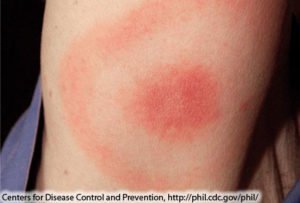Lyme disease is a notorious tick-borne disease. It’s caused by the bacterium, Borrelia burgdorferi, which infects certain types of ticks. If the infected tick bites a human, it can pass this bacterium to him/her, causing Lyme disease.
Insider Info: Not ALL ticks carry Lyme disease. The ticks responsible for causing Lyme Disease are members of the Ixodes species. They include the Ixodes scapularis tick (aka the deer tick) which can be found in the northeast, mid-Atlantic, and north-central parts of the United States and the Ixodes pacificus tick (aka the western blacklegged tick) which can be found on the West Coast.
The Ixodes scapularis tick likes to hang out with (and on) deer (hence its nickname, the deer tick). It looks like this:

Image Source: TickEncounter
The Ixodes pacificus tick (the western-blacklegged tick) has slightly different features and looks like this:

Image Source: TickEncounter
What are the Symptoms of Lyme Disease?
The EARLY Symptoms of Lyme Disease Are:
- A Fever & Chills.
- A Headache.
- Fatigue.
- A Characteristic Bull’s-Eye Rash (fancy name: Erythema migrans). The bull’s eye rash is what most parents associate with Lyme Disease. Here’s what a classic Erythema migrans rash looks like (note it’s “target-like” appearance):

Image Source: CDC
If left untreated, Lyme disease can progress and spread to other parts of the body (think: the joints, the heart, and the nervous system). If caught early enough, though, this later stage of Lyme Disease can be avoided.
Two Classic Findings Seen in the Later-Stages of Lyme Disease Include:
1. A warm, red, and swollen knee (which makes the child limp).
2. Bell’s palsy-the temporary paralysis of one side of the face (i.e. one side doesn’t move well and looks droopy).
The Top 5 Facts to Know About Lyme Disease

1. For a Person to Contract Lyme Disease, the Tick Must Be Attached (And Sucking His/Her Blood) for at Least 36-48 Hours.
2. Not All People Get the Classic Bull’s-Eye Rash, But Most (Read: 80%) Do.1
Insider Info:
- The bull’s-eye rash typically shows up about 1 week after the tick bite (but anywhere between 3-30 days) and expands slowly over a few days.
- The lesion can show up in weird places, like on the back of the neck, in the armpits, or in the groin area. You will, therefore, want to examine your child’s entire body when you check him/her for ticks.
- In some cases, multiple bull’s-eye rashes are present. This doesn’t mean that a child has been bitten by multiple ticks, however, nor does it suggest that he/she has a more serious case of Lyme Disease.
3. Early Blood Tests to Diagnose Lyme Disease Aren’t Very Reliable.
- The early blood tests for Lyme Disease look for antibodies made against the Borrelia burgdorferi bacterium. The problem is the antibodies against Lyme disease don’t appear in the blood for several weeks.
- After 4-6 weeks, the tests become more dependable.
- A test called the ELISA (or IFA) is done first to screen for Lyme disease.
- If the ELISA test is negative, Lyme disease is ruled out.
- If the ELISA test is positive, a confirmatory test called the Western Blot is done.
- If the Western Blot is also positive, the child has Lyme disease.
4. It Helps to Save the Tick: If you see a tick on your child, remove it with tweezers and put it in a Ziploc bag.
Why Would I Want to Do That? So the doctor can determine if the tick is a member of the Ixodes species (the species of tick that causes Lyme Disease). Ticks can also be tested for Lyme Disease, but this practice isn’t usually recommended or necessary.
Here are the Steps to Remove the Tick:
Step 1: Use fine-tipped tweezers to grasp the tick as close to the skin as possible. Avoid squeezing the tick’s body when you do this.
Step 2: Slowly pull the tick away from the skin with a constant, upward pressure.
Step 3: Once the tick has been removed, clean the affected area with rubbing alcohol or soap and water.
Step 4: Store the tick in a Ziploc bag and bring it to the doctor’s office.
5. If a Tick is Found on Your Child, the Doctor MAY (or May Not) Give Him/Her Medication to Prevent the Transmission of Lyme Disease.
Ohhh, Tell Me More…
Studies show that one dose of Doxycycline can prevent the transmission of Lyme disease from the infected tick to the human that’s been bitten.
However, docs don’t prescribe Doxycycline to every person who has a tick found on him/her. In order to receive Lyme disease prophylaxis, the following criteria typically need to be met:
Rule #1: The tick must be an Ixodes type of tick.
Rule #2: The state where the tick bite occurred must have a local Lyme disease infection rate of 20% or more.
Rule #3: The tick must have been attached for 36+ hours.
Reality Check: It’s nearly impossible to tell exactly how long a tick has been attached. If the tick is super engorged (fat), though, that’s a clue that it’s been attached for awhile.
Rule #4: The patient cannot be allergic to Doxycycline.
Common Questions About Lyme Disease

Can Lyme Disease Be Passed Between People (i.e. Is it Contagious)?
Nope. There’s no evidence of that.
Can Lyme Disease Be Treated?
Yes! Lyme disease can be treated with antibiotics. The annoying thing about the treatment, though, is that it takes a while to complete (10 to 28 days depending on the severity of the symptoms).
The two antibiotics most commonly used to treat Lyme disease in kids are Amoxicillin and Doxycycline.
Insider Info: Back in the day, Amoxicillin was used to treat Lyme Disease in children under 8 and Doxycycline was used to treat it in kids 8 and over. Doxycycline was avoided in kids under 8 because it was found to permanently stain their teeth. Studies have since shown that Doxycycline doesn’t have this side effect in kids under 8 as long as the treatment course is 21 days or less.2
I only bring this up because you may find conflicting info about the treatment of Lyme Disease in kids on the web and even among pediatricians. Don’t stress about it, though, your child’s doctor should have you covered.
The Bottom Line
If you don’t like the sound of Lyme disease, you’re in good company. Fortunately, there are ways to protect your child against it.
For Example:
- Have your child wear long sleeved shirts and pants when spending time in the woods and do tick checks on all family members (and pets) when you get home.
PediaTrivia: Experts give conflicting advice about what color clothes we should wear to avoid ticks. For instance, light-colored clothing is thought to attract ticks (which is a negative), but it makes them easier to spot (which is a positive).
Conclusion: There’s no one right answer, so wear whatever colors you’d like.
- Spray yourself and your kiddos on a daily basis with a DEET-containing or Picaradin-containing bug spray during the spring, summer, and early fall.
Get Wise(r) about these two popular types of bug spray.
Parting PediaTip:
Call the doctor ASAP if you think your child has a bull’s eye rash or other symptoms of Lyme Disease. Take a picture of the rash as well.





